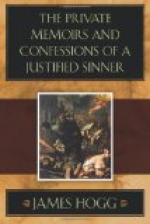|
This section contains 10,665 words (approx. 36 pages at 300 words per page) |

|
SOURCE: Levin, Susan M. “James Hogg: The Private Memoirs and Confessions of a Justified Sinner.” In The Romantic Art of Confession: DeQuincy, Musset, Sand, Lamb, Hogg, Frémy, Soulié, Janin, pp. 99-119. Columbia, S.C.: Camden House, 1998.
In the following essay, Levin elucidates the ironies and ambiguities of Hogg's confessional writing in The Private Memoirs and Confessions of a Justified Sinner.
The confessor of James Hogg's The Private Memoirs and Confessions of a Justified Sinner kills his brother, mother, and finally himself. But his body is miraculously preserved, a freak of nature that may have to do with “the preservation o' that little book,—the private memoirs and confessions of a justified sinner: Written By Himself Fideli certa merces” (228).1 “The reward for the faithful one is sure” is an epigraph that in its ambiguity points to the hideous irony of this confession. Assured of his own Election, Robert...
|
This section contains 10,665 words (approx. 36 pages at 300 words per page) |

|


